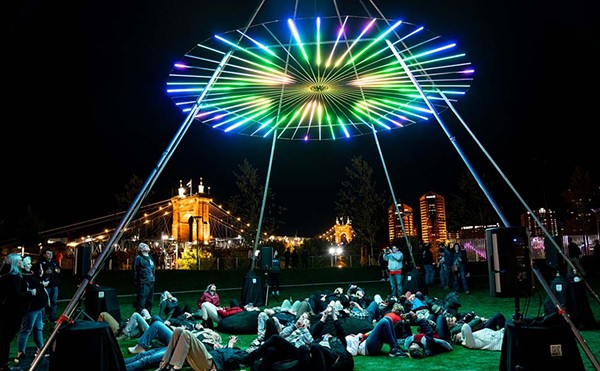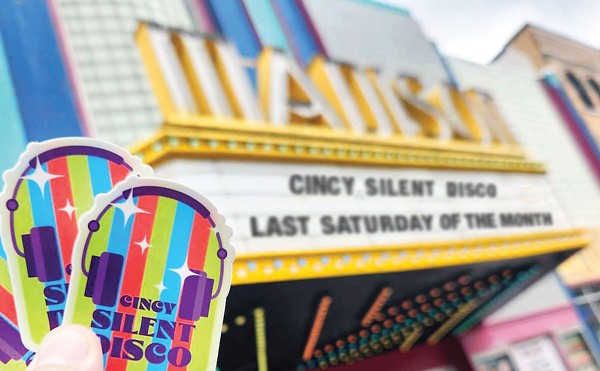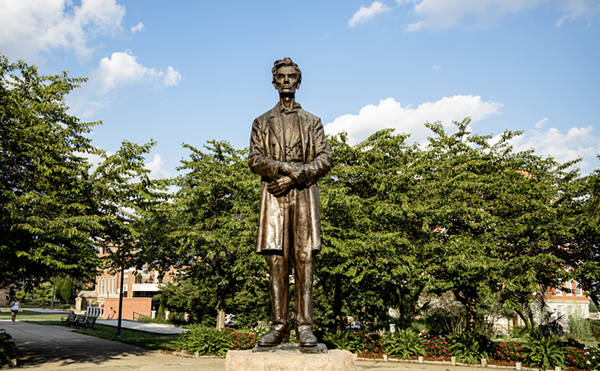To see just how extensively appropriation is being used in contemporary art, it’s useful to compare and contrast two traveling shows now in Cincinnati: Kara Walker’s Harper’s Pictorial History of the Civil War (Annotated) at the Cincinnati Art Museum and Shepard Fairey’s Supply and Demand at the Contemporary Arts Center.
The term “appropriation” is used to describe new art that incorporates in some way a pre-existing work into its imagery.
Both artists are 40 and graduates of the influential Rhode Island School of Design — his degree is undergraduate, hers a Master’s. He’s Southern-born and loves youth culture — not just “street art” but also music, movies and DJing at parties. She’s African American, California-born and the youngest recipient of a MacArthur Foundation genius grant.
If his work is about pop culture (indeed, it wants to be pop culture), hers in Harper’s Pictorial is about American racial history. If his imagery is direct and easily absorbed, hers is layered with levels of meaning that can perplex with their imagery and ambiguity.
There is a historic Harper’s Pictorial — it’s a book of detailed wood engravings about the Civil War’s sobering events, published in 1866. Working at Columbia University, where she also teaches, Walker in an act of appropriation made photo-offset lithographic enlargements of the engravings. Then she overlaid black screen-printed silhouettes of her own invention onto the enlargements in ways that serve as commentary.
They are often of African-American figures with stereotypical features — in itself a rather rude appropriation of the politely quaint art of silhouetting. But Walker succeeds in giving those figures — because they are in the foreground and loom over the details of the original engravings — the last word in her work. (Fifteen prints are included at the CAM show.)
In the piece “Scenes From McPherson’s Death” (Walker uses the titles of the original engravings), a colossus of a silhouetted figure, missing a boot, seems to be standing over the source-material scene waving goodbye while the boot itself is being carried elsewhere. In “Alabama Loyalists Greeting the Federal Gun Boats,” a silhouetted woman on her knees in the foreground, barefoot and hands extended out like a swimmer’s, seems to be trying to fight collapse to get away.
Walker’s execution is impressive. But what’s it all mean? The museum’s wall text suggests she’s saying “no matter which side wins, there will be suffering.” But I wonder if it’s more a case of showing how many additional layers of feeling and meaning — myth and prejudice — must be layered onto any “historical” account of the Old South to get at a greater truth of its racist, pro-slavery past.
Having said that, I find Walker’s use of appropriation much more artistically satisfying that Fairey’s prints and posters. His, however, are the more immediately eye-catching — boldly colorful, clearly representational, often mural-size. So much of his work seems to romanticize pop-culture/street-culture figures that his audience already is predisposed to like it. Its intent seems obvious and borders on flattering his audience’s tastes.
His signature red-white-blue Obama “HOPE” print is special because its impact changed history, a symbol of the idealism and energy young people saw in Obama’s presidential candidacy. But is that impact primarily artistic or political? Fairey’s most interesting art to me is the series that first brought him acclaim, his variations on “Andre the Giant Has a Posse” and the Andre the Giant “Obey” imagery. There, his intent had a mysterious element to it. (Supposedly, “Obey” itself is an appropriation of a theme from the John Carpenter sci-fi movie They Live.)
Amid this discussion of artistic approaches to appropriation, it’s surprising that many resist the use of any appropriation in the visual arts. Why? The purpose, generally, of appropriation is to transform and update the original source’s meaning, sometimes but not always in a critical or satiric way. It’s been around a long time — Marcel Duchamp in 1919 added a mustache to a postcard reproduction of “Mona Lisa” and it became an icon of 20th-century art.
With the explosion of mass media and pop culture, appropriation has become a way for artists to make sense — or not — of the world around them. That some people are skeptical of it as “unoriginal” amazes me, as if a wildlife painter who depicts a tree in 2010 is the first person to ever think of that idea.
But aside from aesthetic debate on appropriation, there are legal issues. It is not a defense for intentional forgery, obviously. And with use of contemporaneous sources, as Fairey does, there is U.S. copyright law to contend with. The law allows for “fair use,” the determination of which can wind up in court.
The Associated Press has contended that Fairey’s “HOPE” print of Barack Obama, based on a photo by AP’s Mannie Garcia, violates its copyright. The result is an ongoing court case; Fairey initiated the suit after AP’s claim. Personally, I think AP is trying to block the doorway of history on this. Fairey clearly transformed the intent and look of a straightforward news photo.
But there’s a complication. According to an Associated Press story — and I’m taking for granted its reliability as a news source on this — Fairey misled a federal court that the Garcia photo was his source. (That could be a consideration in “fair use” cases, one factor of which turns on the extent to which an original, copyrighted work was altered.)
Obviously, it’s wrong to do that under any circumstance and we’ll have to see how it all plays out. But whatever happens, appropriation is as much a part of art nowadays as painting. And these two shows both give insight into how and why it’s done.
HARPER’S PICTORIAL HISTORY OF THE CIVIL WAR (ANNOTATED) is at the Cincinnati Art Museum until May 2. Get show and museum details here.
SUPPLY AND DEMAND is at the Contemporary Arts Center until Aug. 22. Read Matt Morris' interview with Shepard Fairey and get show details here.





